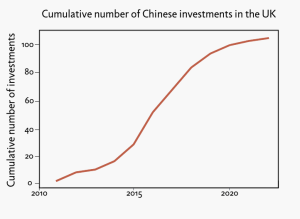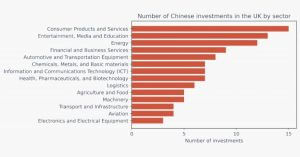Unpacking Chinese investments in the UK
At Datenna, our China experts continuously track and conduct detailed investigations into Chinese FDI in Europe and the US. This article elaborates on Chinese investments in the UK prior to the 2021 National Security and Investment Act coming into force.
Short read
- Companies that are at high risk of state interference account for almost half of Chinese FDI into the UK.
- High-risk and low-risk companies show diverging investment patterns.
- Consumer products and services, entertainment, media, and education attracted the most Chinese investments – and these investments are generally done by low-risk companies.
- Investments in energy, transport, and infrastructure are mostly done by companies with a high risk of government influence.
- The sectoral investment analysis of the risk of state influence is not unique to the UK. Similar investment patterns can be identified in other EU countries.
FDI landscape pre-2021 National Security and Investment Act
This short analysis conducted by Datenna provides a recap of the Chinese investments made between 2011 and 2022.
It is worth noting that most of the FDI data predates the 2021 National Security and Investment Act. This pivotal legislation granted the UK government enhanced powers to scrutinise and intervene in business transactions to safeguard both business and national interests.

The FDI timeline: 2011-2022
An analysis of over 100 enterprises reveals that the most significant surge of Chinese investment in the UK occurred between 2015 and 2019. This surge mirrors trends observed in other EU countries. The sectors that attracted the most Chinese investments include:
- Consumer products and services
- Entertainment, media, and education
- Energy
- Financial service
- Automotive sector

Investor risk levels and sector-specific priorities
We delved further into these investments’ ultimate beneficial ownership, and a striking trend emerged. In 47% of cases, Chinese investing companies showed a medium to high-risk level of state influence. This means that either government entities directly or indirectly owned a significant portion (25%-50% for medium risk, 50% or more for high risk) of the acquired shares, received state funding, or a combination of both.
More than half of the investments came from medium and high-risk investors in specific sectors such as energy, infrastructure, machinery, aviation, logistics, agriculture and food, metals, and basic materials. This percentage surpasses the EU average of 40%, indicating that companies with a higher risk of state influence play a significant role in the UK and EU investments.
Low-risk companies, less likely to be influenced by state objectives, favoured sectors like consumer products and services, entertainment, media, education, financial services, automotive, and ICT. Notably, investments by low-risk companies in consumer products and services included hospitality services such as hotels, clubs, restaurants, or supermarket chains.
High-risk Chinese investors, on the other hand, were concentrated in the energy sector and transport and infrastructure sector. A closer examination revealed that many of these investments involved equity investments in wind farms, aligning with the UK-China strategic partnership on offshore wind energy. This cooperation has brought both commercial and environmental benefits to both countries and beyond.
Balancing risks and benefits
Contrary to common discourse, investments by Chinese companies at a higher risk of state influence do not necessarily outweigh the benefits. These high-risk companies, often state-owned enterprises, tend to be long-term investors. Additionally, lower-risk companies might not have the expertise or capacity to invest in certain industries, leading to a higher presence of high-risk companies in sectors like energy and infrastructure.
In conclusion, every investment in strategic assets carries its own set of risks and opportunities. In an ever-evolving global landscape, understanding the nuances of FDI is crucial. Datenna’s data can assist governments in precisely assessing these variables, providing transparency and traceability when evaluating Chinese investors.